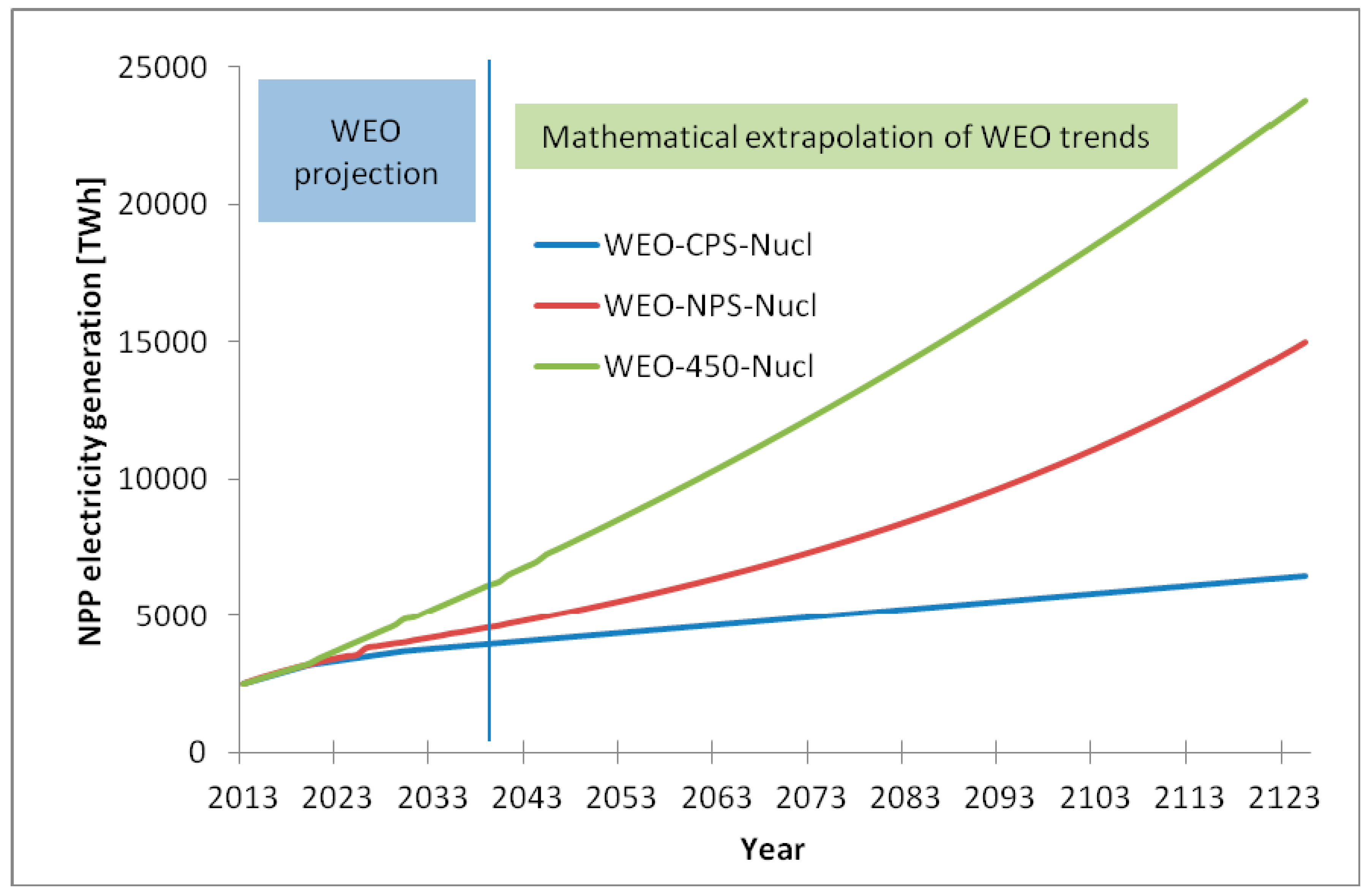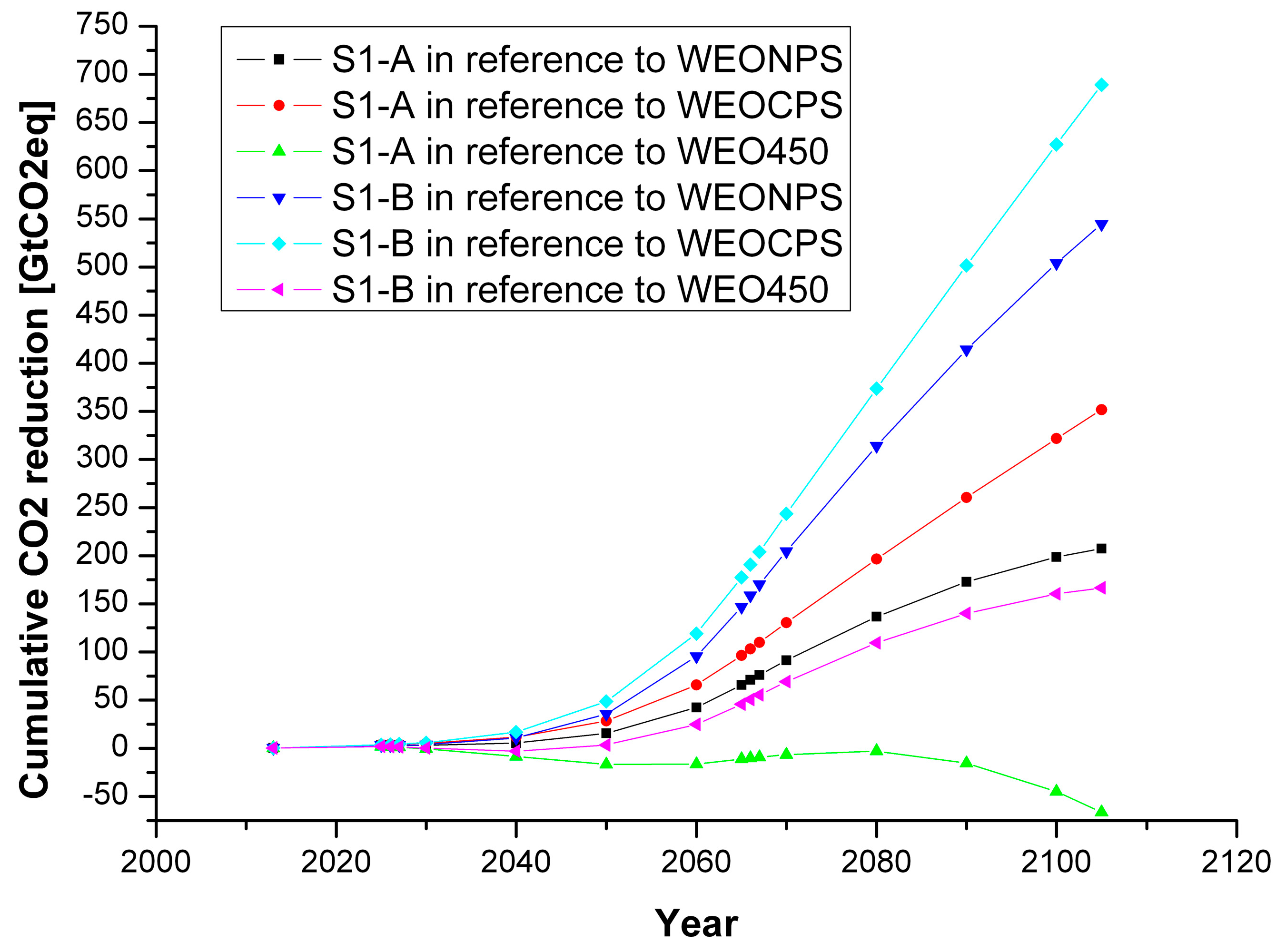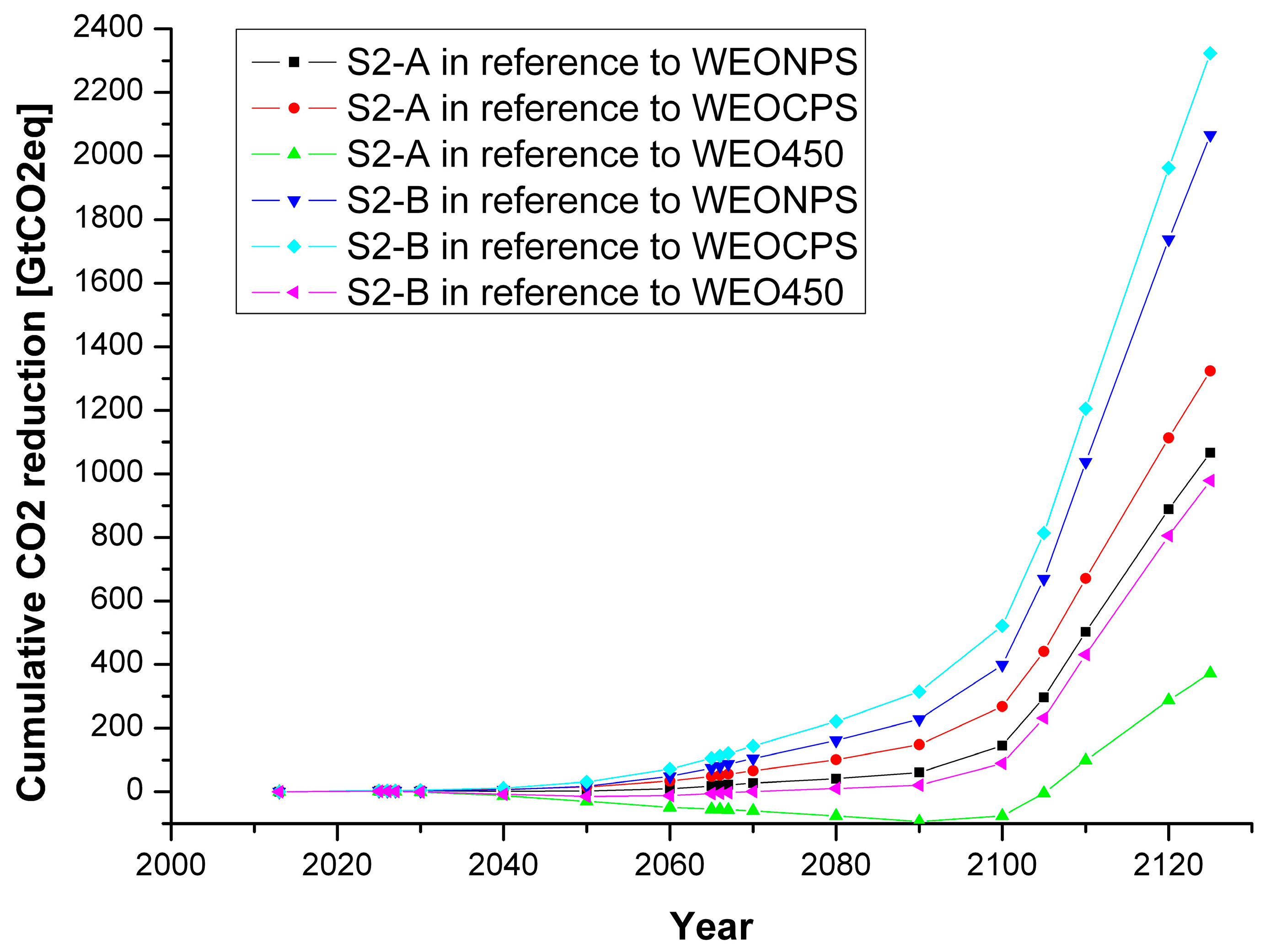Two scenarios have been analyzed based on the presumed NPP life time expectancy, each one having two sub scenarios defined by considered uranium fuel resources. Thus for each scenario, a range of nuclear electricity production and CO2 reduction possibilities have been obtained. There are three key milestone years used in all of the scenarios. The year 2025 is set as the beginning of the extensive LWR buildup; the year 2065 as the final year for LWR build and the beginning of the FBR buildup, and finally the targeted end of the 21 century.
3.1. Scenario S1
In the first scenario (S1), the 40 years’ NPP life time is assumed for all NPPs build within the period 2025–2065. The period from 2013 to 2025 is characterized by low growth of nuclear capacity expressed as the linear growth of nuclear capacity by 1.8% per year containing both, the new builds, as well as old nuclear power plants being decommissioned. In 2025, extensive LWR nuclear buildup would begin and span until 2065.
For sub scenario A, the linear growth of nuclear capacity by 3.85% per year is assumed. However, to account for decommissioning of nuclear power plants build pre-2025, decrease of the total nuclear capacity is obtained by yearly subtraction of the constant value equal to the nuclear capacity in 2025 divided by investigated interval (2065–2025). For example, the proposed 3.85% growth of nuclear capacity in 2026 compared to 485.5 GWe that would exist in 2025 would result in 18.7 GWe of new plants, i.e., total capacity of 504.3 GWe. However, due to foreseen closure of 12.1 GWe of pre-2025 nuclear power plants, the total installed nuclear capacity for 2026 would be considered to be 492.1 GWe. For the year 2027, the growth of 3.85% would be applied to the uncorrected value of 504.3 GWe resulting in 19.4 GWe newly build nuclear capacity, which after subtraction of 12.1 GWe of decommissioned plants results in total nuclear capacity of 499.4 GWe. Although, a simpler type of calculation, similar to the one applied for the period 2013–2025, could have been used, we believe that the aforementioned approach is better in simulating the decommissioning of pre-2025 nuclear power plants. For the period 2065–2105, no new LWR builds are foreseen. The total LWR nuclear capacity decreases due to decommissioning. For example, all nuclear power plants that would be built in 2026 with the capacity of 18.7 GWe are foreseen for closure in 2066. The applied dynamics of LWR capacity buildup in the overall period 2013–2065 results in cumulative uranium requirements until 2105 reaching approximately 16 MtU, which were preset as the bottom uranium fuel resource constraint.
For sub scenario B, the linear growth of nuclear capacity by 4.85% per year is assumed, following same methodological approach as described for sub scenario A. The applied dynamics of LWR capacity buildup in the overall period 2013–2065 results in cumulative uranium requirements until 2105 reaching approximately 24 MtU, which were preset as the top uranium fuel resource constraint.
In sub scenario A, the overall LWR capacity in 2065 is 1715 GW, while in sub scenario B it reaches 2743 GW.
FBR buildup starts in the year 2066 and spans until 2105. The proposed and investigated dynamics of the FBR buildup for both of the sub scenarios is based on the compensation of nuclear capacity lost due to LWR decommission. For example, in sub scenario A it is assumed that 18.7 GWe of FBR capacity would become operational in 2066, thus replacing 18.7 GWe of LWRs scheduled for decommission in that year.
The proposed dynamics of LWR/FBR buildup for scenario S1 is presented in
Table 1 with results given for selected years enabling a better understanding of the methodology used.
Annual and cumulative uranium requirements, as well as plutonium production and requirements for LWR/FBR buildup proposed in scenario S1 sub scenario A are given in
Table 2 (bottom uranium fuel resource constraints are applied).
Table 3 gives the corresponding data for sub scenario B where top uranium fuel resource constraints are applied. Plutonium buildup resulting in LWR operation by 2065 would be used to start the gradual buildup of FBR fleet. Due to decommission of LWRs, annual plutonium production in LWRs would decrease after 2065 while, at the same time, plutonium requirements due to FBR operation would increase. However, due to the breeding ratio of 1.1, additional plutonium is also generated in FBRs. With proposed FBR buildup dynamics, overall production of plutonium becomes higher than its requirements by 2080 for both sub-scenarios (lines marked by red in
Table 2 and
Table 3).
To estimate the possible impact of strong nuclear buildup on CO
2 emission reduction one has to compare the production of electricity in proposed scenarios to the ones obtained by extrapolation of WEO reference scenarios. Electricity surplus could then be used to replace electricity produced in fossil-fired power plants. Electricity surpluses for scenario S1, sub-scenarios A and B are given in
Table 4 and
Table 5, respectively. It is interesting to notice that negative electricity surplus was obtained when comparing electricity production in proposed sub-scenarios with the WEO 450 scenario. However, the electricity production in WEO 450 scenario is a result of mathematical extrapolation of the values given for the period 2013–2040 without taking into account nuclear fuel resources’ constraints imposed on proposed scenarios. Under such conditions, WEO 450 scenario would run out of resources by 2088 (bottom constraint) and 2105 (top constraint), leaving the LWR fleet, even the LWRs that would be just then built, without necessary uranium. Despite the fact that in the proceeding analysis WEO 450 scenario would still be examined, the obtained results should be carefully considered having in mind previously stated facts.
As previously indicated, the surplus of nuclear electricity production could be used to replace fossil produced electricity, thus effectively reducing the CO
2 emission. The extrapolation of electricity production in coal power plants from WEO scenarios indicates that the obtained surplus (
Table 4 and
Table 5) is smaller than the coal-produced electricity for CPS and NPS scenarios. Therefore, the difference of the lifecycle CO
2 emission factors between coal and nuclear (820 gCO
2eq/kWhe−12 gCO
2eq/kWhe) can be used to calculate possible CO
2 reduction. As far as WEO 450 scenario coal electricity extrapolation and its comparison to obtained WEO 450 nuclear electricity surplus is concerned, the problem would arise for the period from 2063 till 2071 for sub-scenario A and period from 2053 till 2105 for sub-scenario B. The obtained surplus is higher than the extrapolated coal electricity production. Therefore, the surplus should be used to replace electricity from gas power plants with smaller difference between lifecycle CO
2 emission factors (490 gCO
2eq/kWhe−12 gCO
2eq/kWhe). Possible CO
2 emission reduction for scenario S1, sub-scenarios A and B are given in
Table 6 and
Table 7, respectively.
The possible CO
2 emission reduction is significant, especially in the period 2060–2080 for both sub scenarios. However, in the first half of the century, the proposed investigated sub scenarios result in modest CO
2 reduction when the analysis is performed in the context of WEO NPS and WEO CPS scenarios’ extrapolation. For WEO 450 scenario extrapolation, there is no CO
2 reduction. On contrary, the emission increases. One has to be reminded that WEO 450 scenario extrapolation is unfeasible due to uranium fuel outage. Since available research, for example [
13], indicates that CO
2 emission reduction should be urgently accomplished, it is evident that investigated LWR/FBR buildup could not solely accomplish the task. Cumulative CO
2 reduction for both sub scenarios in comparison to WEO reference data extrapolation is graphically depicted in
Figure 2.
3.2. Scenario S2
In the second scenario (S2), the 60 years NPP life time is assumed for all NPPs that would be built within the period 2025–2065. As in the scenario S1, the period from 2013 to 2025 is characterized by low growth of nuclear capacity expressed as the linear growth of nuclear capacity by 1.8% per year containing both, the new builds, as well as old nuclear power plants being decommissioned. In 2025, extensive LWR nuclear buildup begins and it spans until 2065. Two sub scenarios are analyzed: sub scenario A affected by the bottom uranium fuel resource constraint, and sub scenario B affected by the top uranium fuel resource constraint. The methodology that would be used for LWR buildup in the period 2025–2065 is identical to the one used for scenario S1. To satisfy the imposed constraints, the resulting linear growths of nuclear capacity by 3.1% and 3.98% for sub scenarios A and B, respectively, have been assumed. In sub scenario A, the overall LWR capacity in 2065 is 1161 GW, while in sub scenario B it reaches 1828 GW. As expected, both values are substantially lower than those obtained in scenario S1 (1715 GW and 2743 GW, respectively).
Due to the 60 years’ life time NPP, in the period 2065–2085 the LWR capacity would not change and would maintain the values from 2065. After that, gradual decrease of capacity starts due to decommissioning, and finally reaches zero level in 2125.
FBR buildup would start in the year 2066. As opposed to scenario S1 where the dynamics of FBR build has been linked to decommissioning level of LWRs, in scenario S2 there is more flexibility in setting up the FBR dynamics, especially for the period 2066–2085. After analyzing a number of options, we decided to present the dynamics of FBR build based on linear growth of installed capacity, which would result in CO2 emission reduction in 2105 similar to the one obtained in scenario S1. It is assumed that the capacity of the FBR fleet does not change after 2105.
The methodology used in the analysis is identical to the one used in the previous scenario. Therefore, calculational intermediate steps are not given. The proposed dynamics of LWR/FBR buildup for scenario S2 is presented in
Table 8, while finally obtained CO
2 emission reduction for scenario S2, sub-scenarios A and B are given in
Table 9 and
Table 10, respectively.
Similar to scenario S1, the possible CO
2 emission reduction in both S2 sub scenarios is significant. However, the reduction is achieved mostly at the end of the century and at the beginning of the 22nd century. Once again, it is evident that nuclear energy cannot solely solve the CO
2 emission reduction task. Cumulative CO
2 reduction for both sub scenarios in comparison to WEO reference data extrapolation is graphically depicted in
Figure 3.









